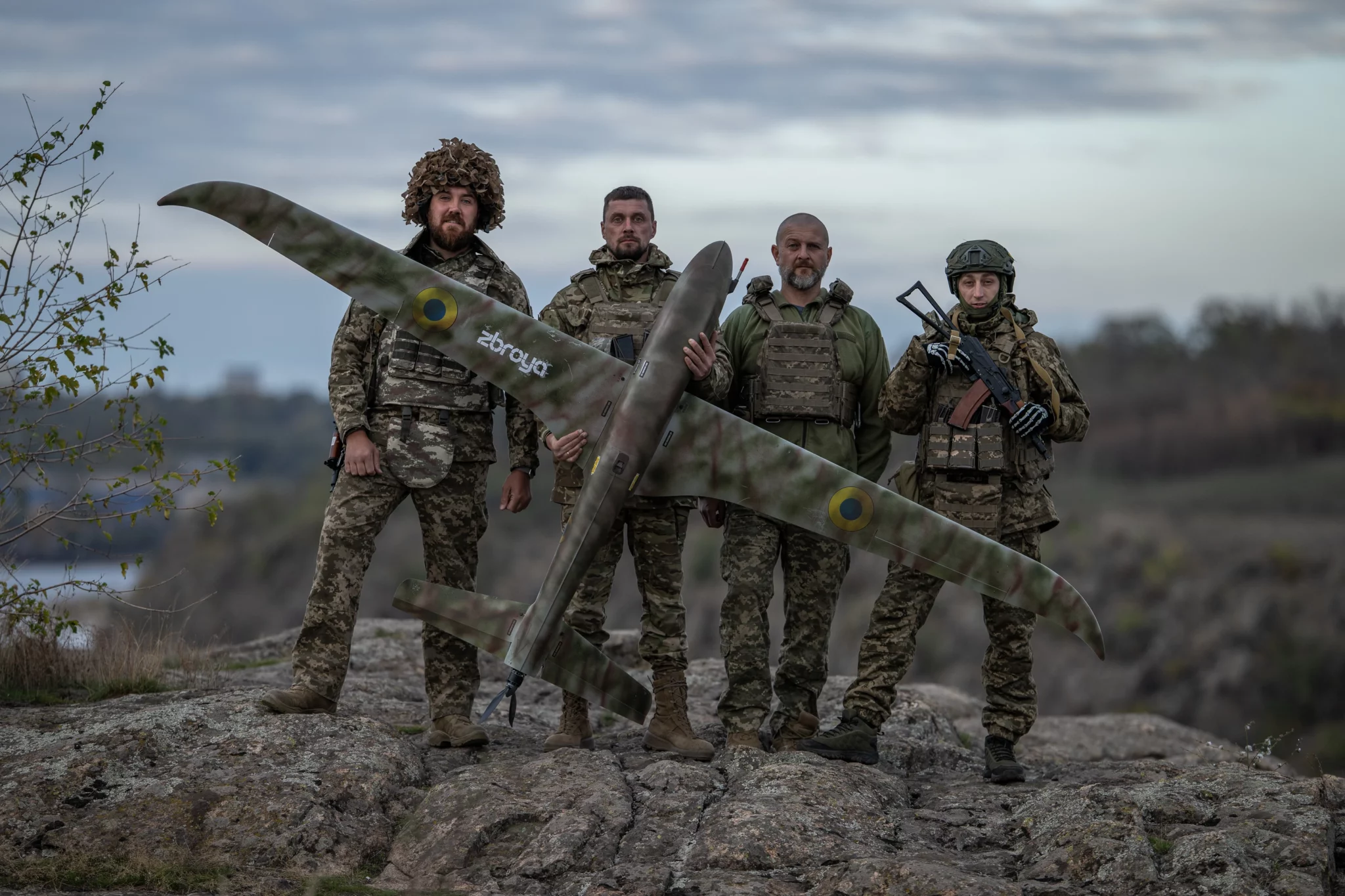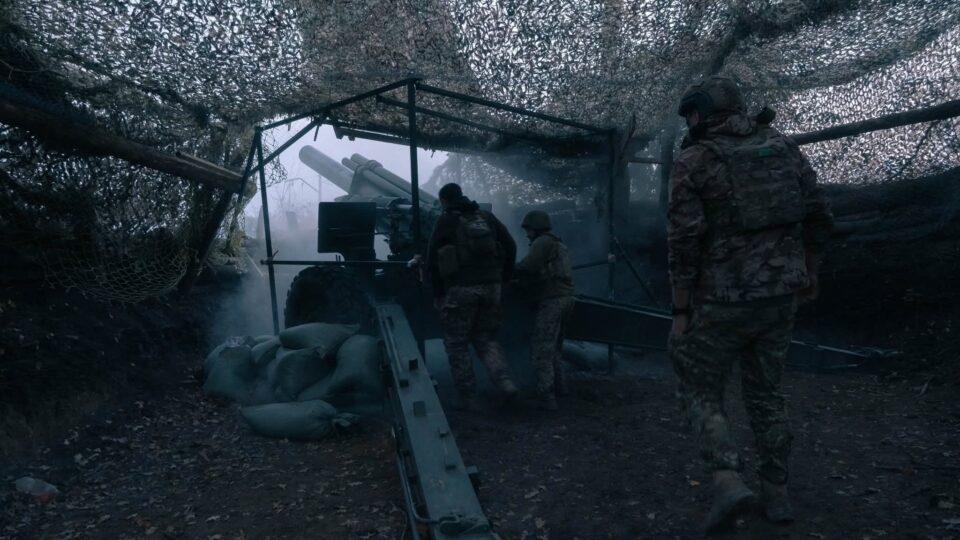At the moment, the Non-Commissioned Officer Corps of the Armed Forces of Ukraine — which includes more than 250,000 sergeants…

“Domakha”, “Furia”, SHARK, Cetus, and Songbird — a group of five unmanned aerial vehicles used by the 411th Separate Unmanned Systems Regiment “Yastruby” for reconnaissance deep in enemy territory.
The beauty of the winged drones and the Ukrainian defenders who pilot them has been captured in a photo report by ArmyInform.
“And Zalizniak in the land of Smila tempers his domakha”, — wrote Taras Shevchenko in his poem Haidamaky, referring to an old Cossack saber called a “domakha”. Made from high‑quality Damascus steel, it was a formidable weapon known for its durability, flexibility, and sharpness.
The name of the modern Ukrainian reconnaissance and fire‑adjustment UAV “Domakha” evokes this now‑forgotten word — and rightly so. It perfectly suits a drone whose main task is to detect enemy targets and adjust artillery fire for their destruction.
“Domakha” combines the traditional warrior’s craftsmanship with modern technology. This drone is the “quiet saber” of today’s battlefield — fast, precise, and invisible to the enemy. It reminds us that today’s Ukrainian drones inherit an ancient weapons‑making culture: Ukrainians have always mastered both foreign and self‑made weapons.
Thus, the “Domakha” UAV is not just a technical device but also a metaphor for Ukrainian strength and tradition — just like the Damascus saber was once a symbol of honor and mastery in battle. Two crossed sabers beneath the blue‑yellow flag and the trident on the drone’s emblem directly highlight this continuity of Ukrainian valor.
Soldiers prepare “Domakha” for launch — and moments later the combat drone slices through the air like a sharp saber, carrying “eyes” for accurate strikes by Ukrainian artillery, and death and destruction for the enemy who vainly attempts to hide from its keen gaze.
The Furies were ancient Roman goddesses of unrestrained fury, merciless vengeance, and relentless pursuit of wrongdoers. With whips and torches in their hands, the terrifying winged sisters hunted sinners and brought inevitable punishment upon them.
The reconnaissance and artillery‑adjustment UAV “Furia” bears its name because it behaves toward the enemy exactly as the mythical sisters did — detecting with a sharp eye, chasing on swift wings, and directing the full fury of Ukrainian artillery onto the invaders.
The A1‑CM “Furia” UAV is a highly precise and sophisticated aircraft requiring careful handling and professional maintenance. In the hands of Ukrainian fighters, the flying drone works like a conductor’s delicate and sensitive baton, masterfully directing a deadly “symphony” of artillery strikes.
Photographing “Furia” in flight is not easy — it is fast and flies far. It rises high above the battlefield, soaring beyond human sight and even professional equipment. But on the ground, in the hands of Ukrainian soldiers, it obediently and gently “poses” for the camera, showing the sleek, aerodynamic lines of its winged body.
Inspection and launch preparation, a taut launch cord — and the “flying wing” leaps from their hands and ascends into the sky. Moments later, the aircraft disappears into the heights — “Furia” has departed on a combat mission. Soon it will “report back” with valuable information everyone awaits.
The SHARK UAV is named for its visual resemblance to the elegant yet deadly ocean predator. Though its domain is not water but the boundless sky over the battlefield, it glides above the earth with the same predatory grace as a shark in the deep.
To the enemy, the SHARK is as dangerous in the air as the silent, toothy fish is to its prey underwater. The mission of this winged drone is to detect, track, and direct Ukrainian Defense Forces’ weapons onto enemy targets. Wherever the cold gray shadow of SHARK flashes over the ground, inevitable death awaits the occupiers.
For Ukrainian soldiers, however, SHARK is a loyal friend and helper — provided they care for it properly. In the hands of experienced drone operators, it becomes not just a high‑precision device but a truly perfect aerial predator.
SHARK hunts occupiers as if it can sense the smell of their black blood from dozens of kilometers away. After launch, its sleek “snout” carefully scans the earth and inevitably identifies the enemy, no matter where they try to hide.
When the drone rises into the air, its two wings beside the fuselage resemble a cross in the sky. When Ukrainian soldiers carry it before launch, they look like the Savior bearing His cross to Golgotha. This striking symbolism reflects the truth: every Defender carries their own cross in service to the Ukrainian people.
The Flirt Cetus UAV is a Ukrainian fixed‑wing drone designed for aerial photography, topographic surveying, and multispectral monitoring of large areas with high precision. Its name combines ancient mythology and astronomy, emphasizing the drone’s unique features.
Cetus, the Whale of Greek myth, was a giant sea monster sent by Poseidon to punish Queen Cassiopeia’s pride. In modern astronomy, Cetus is one of the largest constellations in the sky, preserving its ancient Greek name.
As a UAV name, Cetus symbolizes great power moving through the depths — a formidable force reflecting the capabilities of a durable drone designed to operate over vast distances. The astronomical association highlights its long range, autonomy, and navigation accuracy.
In essence, the Cetus UAV is a heavyweight reconnaissance drone meant for deep‑rear missions. Launched from a catapult for long‑distance flights, Ukrainian soldiers trust that the celestial “Whale” will not fail — it will gather crucial intelligence and return safely.
Together with the shark‑like SHARK, Cetus carries out specific missions in the enemy’s skies, operating where this type of UAV is most effective. The hefty, round‑bodied “Whale” resting on a Ukrainian warrior’s shoulder is a powerful reconnaissance tool and a significant argument in the fight against the enemy.
The name of the UAV Songbird translates as “Spivacha Ptashka” — “Songbird.” It symbolizes lightness, silence, and freedom of flight. The drone soars through the sky as though singing — so natural and elevated is its movement. With vertical takeoff and landing, it rises into the air and returns to the ground like a real bird.
In Ukrainian skies, Songbird is above all an all‑seeing scout capable of operating far from the frontline, deep in enemy territory, remaining airborne for long periods and transmitting clear real‑time observation data. Thanks to its hybrid design, Songbird can take off and land almost anywhere, making it convenient in field conditions.
The “Songbird” can work where other drones may be limited by takeoff conditions or range. Light, precise, and nearly silent, it combines the endurance and distance of a fixed‑wing drone with the flexibility of a multirotor. This makes it a valuable addition to the fleet of reconnaissance UAVs used by the Ukrainian Defense Forces.
Moreover, Songbird operates fully automatically — with auto‑takeoff, auto‑landing, programmed routes, and a return‑to‑base function. A single operator can control it via onboard controller or ground station, and for transport it can be easily disassembled into a compact case.
Like a true hardy bird, Songbird can operate in adverse weather — strong winds, low temperatures, or rain. Ukrainian soldiers speak warmly and affectionately about their “Songbirds,” treating them as living beings — loyal friends and helpers.
@armyinformcomua

Deputy Minister of Defense of Ukraine Hanna Hvozdiyar held a meeting with the International Monetary Fund mission led by Gavin Gray.

Over the past 24 hours Ukrainian forces carried out strikes on two enemy concentration areas.

“I have an anniversary tomorrow”, — says Azov fighter Rusty. “My release from captivity. It’ll be exactly a year”.

The Defence Forces are holding back the enemy and conducting search-and-strike actions to eliminate Russian troops in Pokrovsk. Ukrainian positions remain in the city centre, small-arms battles continue, and the enemy is unable to gain a foothold.

Losses of Russian artillery systems in the first 11 months of the current year have already surpassed last year’s figures.

Over the past day, Russian invaders lost 1,190 troops killed and wounded, as well as 564 units of military equipment.
At the moment, the Non-Commissioned Officer Corps of the Armed Forces of Ukraine — which includes more than 250,000 sergeants…